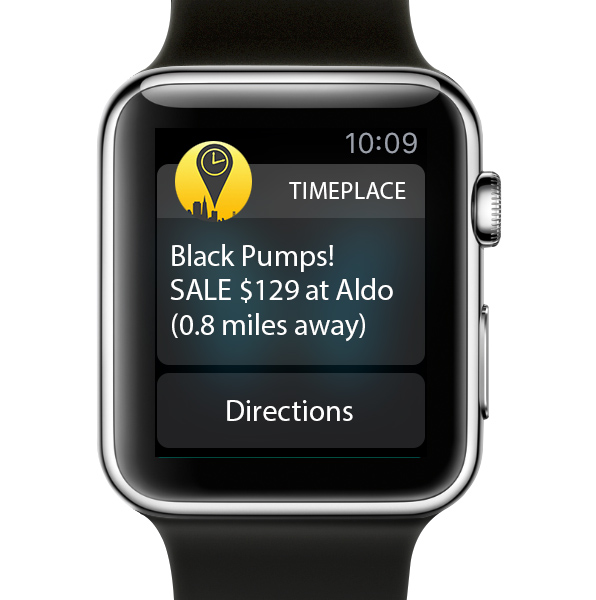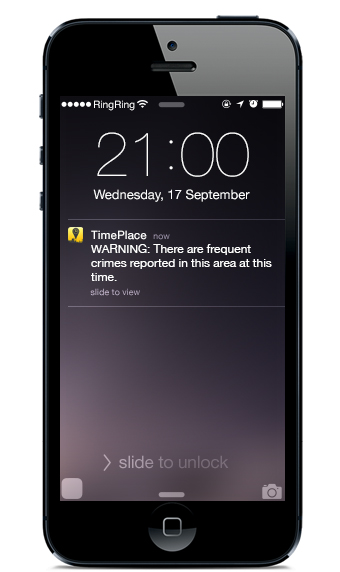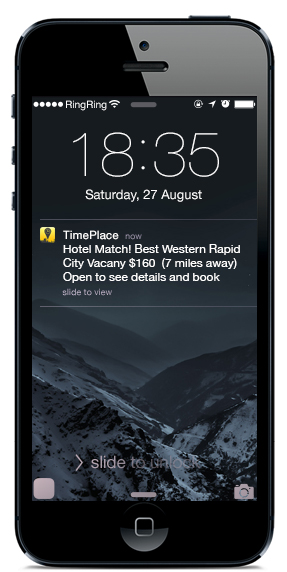The Power of Time and Location: a visionary look into the possibilities of using technology to help both consumers and merchants connect in a contextual manner.
While 10 year olds own iPads, watches are monitoring our heartbeats, and the Internet is getting more powerful by the day… have we really pushed our devices and the Internet to its full potential?
For example, the retail industry is still wildly inefficient. Stores, hotels, restaurants, service suppliers, all have an inventory of products or services readily available to the consumers who want or need them. But how often do those consumers find the exact thing they are looking for at the right time and place without wasted effort searching? Rarely.
Companies like Amazon have satisfied the online shoppers need for instant purchases and have given customers the ability to comparison-shop by digging through millions of inventory by keywords, sorting and filtering techniques. However, e-commerce is still missing one piece that even free 2-day shipping cannot solve. There are still many people who want to see, feel, and test a product before making a purchase decision. Online shopping has undoubtedly added convenience to the shopping world, but it can never replace the positive experience of picking out, trying on, and buying the perfect black pumps on sale and taking them home right on the spot. The future of brick and mortar retail is not just about transferring every transaction to our computers, phones, or tablets, but it is about utilizing location and learning technology to redesign the retail industry to be more efficient for both merchants and consumers. So how do we do this?

Example of potential use of Apple Watch
At TimePlace, we love to imagine how technology will change our future. Imagine a future world of e-commerce where consumers can call out their product wants and needs. “Black Suede Pumps under $200” “Happy Hour wine deals” and retailers can listen and notify the consumer that they have exactly what they are looking for. “Steve Madden Black Pumps for $180 $129 at Nordstrom (0.8 miles away)” “Happy Hour at Dirty Water SF 5-7PM. $12 wine flights (1 mile away)”
A platform that connects merchants and consumers would be something great, but a platform that utilizes time, location, and a user’s intent to deliver information to the consumer would be exceptionally innovative. The customer doesn’t want to spend wasted effort at a mall going from store to store, and the merchant can focus on capturing and marketing to the people actually interested in what they’re selling maximizing marketing spend. Taking the guessing game out of searching for a specific product or service would dramatically change the retail industry and bring back life and purpose to the brick and mortar retail establishment.
While the retail industry would undoubtedly benefit from this technology, this approach can be leveraged for many other types of data and scenarios. Utilizing a powerful platform to arrange, display, and deliver data by time and location can increase the power and utility of the data and with creative developers and designers can optimize the transactions that occur. Whether the data is inventory, historical crime data, iOT information from home sensors, or on-sale alerts pushed by merchants, this platform can completely change the way we all use the large amount of data in the world.
As described in the book the Intention Economy by Doc Searls, this future method of commerce focuses on what the buyer wants and gives the seller the ability to market to the right people in the right context. He describes a future where marketing moves from the historical push model born from the days of early radio and television when there was one or 2 channels, to a highly optimized communication based on users intent and sellers ability to see the user signals of what they want to buy.
The TimePlace platform is all that it name implies, Time and Place. We can ingest any type of data and beautifully, usefully,  and simply display it according to its time and location. For retail, we could utilize what the user has declared they are looking for (suede pumps, happy hour deals) and display deals or sales that match their needs at a specific time and place. Of course, our retail example is only a stepping-stone to the possibilities this platform has in the future. Another useful way to use this technology could be with historical crime data. Every large city unfortunately has areas that locals know are more dangerous than others, but how would tourists know this without extensive research? Not something that would be likely to happen when planning a trip. By indexing historical crime data by time and location our platform would allow us to display or warn users that they are in an area that is dangerous at that current time of day.
and simply display it according to its time and location. For retail, we could utilize what the user has declared they are looking for (suede pumps, happy hour deals) and display deals or sales that match their needs at a specific time and place. Of course, our retail example is only a stepping-stone to the possibilities this platform has in the future. Another useful way to use this technology could be with historical crime data. Every large city unfortunately has areas that locals know are more dangerous than others, but how would tourists know this without extensive research? Not something that would be likely to happen when planning a trip. By indexing historical crime data by time and location our platform would allow us to display or warn users that they are in an area that is dangerous at that current time of day.
Finally, our visionary look into the future of the TimePlace platform revolves around a simple example of a road trip. Driving down the I-90 a group of friends know that they can drive for a couple more hours but need to eventually find a hotel on their route within their price range. The group declare s their intent as the customer, “Hotel on route, under $200” 30 minutes later they receive a notification with a match from a qualified hotel and they are able to book the room on the spot. No extensive searching on hotel sites with often outdated or expired information on price or vacancy. With this platform, the group receives relevant and specific data that allows them to enjoy the ride while their “agent” searches for the room they want.
s their intent as the customer, “Hotel on route, under $200” 30 minutes later they receive a notification with a match from a qualified hotel and they are able to book the room on the spot. No extensive searching on hotel sites with often outdated or expired information on price or vacancy. With this platform, the group receives relevant and specific data that allows them to enjoy the ride while their “agent” searches for the room they want.
Utilizing learning algorithms, social APIs, and users stated intentions, this platform can adapt to the users interests, patterns, and future travel plans and provide them with useful information based on time and location. While Tinder matches person to person, TimePlace can match the buyer to the seller, and the user to the data. With iOT steadily increasing and data becoming more available and detailed, It’s time we take a look at how we can utilize this fact to change the world. Let us be the concierge for the digital age; let us make the world more efficient, so we can start living instead of searching.